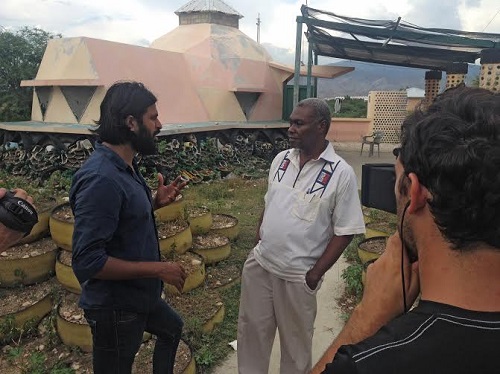
Vice correspondent Vikram Gandhi with Camille Chalmers, executive director of the Haitian Platform to Advocate Alternative Development.
Credit: Courtesy of HBO
April 24, 2015;This newswire was written based upon advance viewing.
When Vikram Gandhi presents tonight’s VICE story on U.S. aid to Haiti—“Haitian Money Pit”—the story will have news both new and old.
The new news is that Gandhi names places and names where U.S. aid to Haiti was misused, abused, ripped off, and generally screwed up.
Sign up for our free newsletters
Subscribe to NPQ's newsletters to have our top stories delivered directly to your inbox.
By signing up, you agree to our privacy policy and terms of use, and to receive messages from NPQ and our partners.
It’s about time that the American public learned firsthand, with poignant video, about the misguided direction and use of much of the charitable and governmental aid that went to help Haiti recover from the devastating earthquake that hit Port-au-Prince on January 12, 2010. The show, which will be aired on HBO at 11pm Eastern on Friday, hits on a variety of programs and practices that were inflicted on Haitians in the name of humanitarian relief and longer-term development assistance—some stupefyingly horrific, some darkly comic, including the following:
- $10 billion in aid to Haiti that still hasn’t led to permanent housing or decent water and sewage systems, leading to Haiti’s suffering the largest modern outbreak of cholera in history. Seven hundred thousand people affected—and nearly 9,000 deaths—from a disease that’s preventable through providing people with clean drinking water. The problem of polluted water supplies causing cholera continues even today.
- For every dollar of U.S. government aid to Haiti through USAID, only one cent went to Haitian organizations, Haitian companies, or even the Haitian government, as opposed to contracting with non-Haitian organizations, nonprofit and for-profit, for the delivery of aid.
- There were plans to build 15,000 houses at a cost of $53 million, but according to Gandhi’s sources, the cost ballooned to $93 million and the number of homes to be built shrunk to 2,600. At the same time, the U.S. embassy authorized $70 million to build townhouses with pools for U.S. embassy staff—with functional electric power and clean drinking water, which is unavailable for most everyone else in Haiti.
- On the darkly comic side are the model homes built for the Zoranje housing festival, supported by the Clinton Foundation among others, a $2.4 million “showroom” for international firms to build prototype houses in the expectation of winning contracts for mass production. The homes ranged from the impractical (for example, wood homes in a nation that has been largely deforested) to the nutty (you have to watch the show to see just how insane some of the models were), and not one house model was used to make homes for Haitians anywhere, other than the ones who moved into the demonstration models after the “expo”—Gandhi calls it “squatting in a permanent reminder of what our aid intended to give them.”
- In some cases, Haitians who “received little to no foreign aid actually appeared to be doing better than those in designated relief areas,” Gandhi found.
- “Adding injury to insult,” in Gandhi’s words, the International Olympic Committee built an $18 million state of the art soccer field and recreational center for a community where residents lived, typically squatted, in shantytown housing without basic public services such as clean drinking water.
- $300 million in aid spent in Caracol, seven hours north of the earthquake, where the earthquake didn’t really hit, providing yet another soccer field, a cultural center, and other facilities, but really geared toward a $260 million industrial park that was planned long before the earthquake.
- The use of U.S.-based contractors, notably USAID’s largest contractor, Chemonics International, to build much of the useless stuff that isn’t helping Haitians in need.
Gandhi concludes early on that “long term relief aid to Port-au-Prince appear[ed] to be squandered,” emblematic of a consistently troubled dynamic of the delivery and use of aid in Haiti, to the benefit of people and interests who weren’t Haitian or, if occasionally Haitian, weren’t directly affected or displaced by the earthquake (as in Caracol, seven hours north of Port-au-Prince). No one from USAID was willing to be interviewed for the VICE show to address the issues Gandhi reported upon, which is more than telling about USAID’s role in the misguided Haitian relief strategy pursued.
In a way, however, though some of the incidences of screwed up aid are new to American viewers, the underlying issues are old news, with lessons that NGOs, for-profit aid deliverers, and donor countries seem to learn—and then forget, or perhaps ignore—over and over again. Among the obvious lessons Gandhi implies or surfaces are these:
- The donors and the implementers frequently didn’t talk to Haitians about what they wanted and about what they needed.
- In many cases, the donors were planning showcases for themselves and their interests—for example, the soccer fields next to shanty homes without basic plumbing, which simply underscored their cluelessness.
- By circumventing Haitian institutions, donors and implementers weakened rather than strengthened systems of governance.
- By failing to work on basic infrastructure such as water, sewerage, and power, they left Haitians vulnerable and in prolonged conditions of underdevelopment.
- Part of the problem of USAID-funded solutions are the rules that the U.S. Congress imposes on aid, including requiring U.S. contractors for various services and U.S. supplies, thus bypassing and weakening local markets.
- Another part of the problem are the USAID instructions to contractors, which will build what they are told to build, like the $2.3 million police station in Caracol, with the cost estimates redacted from public disclosures on the projects.
Ultimately, this dynamic is to some extent what Gandhi called “disaster capitalism” and what the U.S. ambassador to Haiti called in a leaked document “the gold rush.” But it isn’t just the for-profit contractors like Chemonics. The fault is partly in the development industry’s continued failure to build and strengthen local governance and local civil society, and partly in the government policies of the U.S. that lead to bids and contracts to do the things like Chemonics has built. In other words, if USAID RFPs it, Chemonics and others—both for-profit and nonprofit—will build it. We all know better. Gandhi’s story should have resonance.—Rick Cohen












